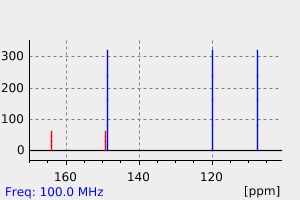2,2'-difluoro-[4,4']-bipyridinyl
中文名称
——
中文别名
——
英文名称
2,2'-difluoro-[4,4']-bipyridinyl
英文别名
2,2'-difluoro-[4,4-bipyridine];2-Fluoro-4-(2-fluoropyridin-4-yl)pyridine
CAS
——
化学式
C10H6F2N2
mdl
——
分子量
192.168
InChiKey
GVCHMHKTACCNMG-UHFFFAOYSA-N
BEILSTEIN
——
EINECS
——
-
物化性质
-
计算性质
-
ADMET
-
安全信息
-
SDS
-
制备方法与用途
-
上下游信息
-
文献信息
-
表征谱图
-
同类化合物
-
相关功能分类
-
相关结构分类
计算性质
-
辛醇/水分配系数(LogP):2.3
-
重原子数:14
-
可旋转键数:1
-
环数:2.0
-
sp3杂化的碳原子比例:0.0
-
拓扑面积:25.8
-
氢给体数:0
-
氢受体数:4
反应信息
-
作为产物:描述:2-氟-4-碘吡啶 在 palladium diacetate 、 caesium carbonate 、 2'-(dicyclohexylphosphanyl)-N2,N2,N4,N4-tetramethyl-[1,1'-biphenyl]-2,4-diamine 作用下, 以 乙腈 为溶剂, 以52 %的产率得到2,2'-difluoro-[4,4']-bipyridinyl参考文献:名称:光诱导的 Pd 催化剂能够实现 C(sp2)–C(sp2) 交叉亲电子偶联,绕过金属转移的需求摘要:过渡金属催化交叉偶联是构建(杂)联芳基支架的通用工具。然而,使用丰富的(杂)芳基卤化物和拟卤化物的交叉亲电子偶联仍处于起步阶段。特别是,用于交叉亲电子偶联的稳健且通用的方法将允许无与伦比地进入大量市售的、结构多样的(杂)芳基卤化物和拟卤化物作为偶联伙伴。在这里,我们展示了一种配体控制的可见光驱动的单金属交叉亲电子试剂偶联平台,其中双钯催化循环的协同操作根据键解离焓来区分亲电子试剂。该方法温和且具有选择性,对多种官能团和具有挑战性的杂芳基显示出功效。通过各种药物的(杂)联芳核心的合成和肽的多样化,揭示了这种转化的力量。该技术绕过了传统的金属转移步骤,为(杂)芳基卤化物和拟卤化物的交叉亲电子偶联提供了通用策略。DOI:10.1038/s41929-024-01109-4
文献信息
-
Synthesis of Pyridinyl-Pyrimidines via Pd-Catalyzed Cross-Coupling Reactions: A Comparison of Classical Thermal and Microwave Assisted Reaction Conditions作者:Peter Stanetty、Michael Schnürch、Marko D. MihovilovicDOI:10.1055/s-2003-41414日期:——The Negishi cross-coupling reaction was used for the synthesis of pyridinyl-pyrimidines utilizing classical thermal or microwave assisted conditions. The organozinc substrates were prepared from 2-fluoro-4-iodopyridine byconventional lithiation chemistry and subsequent transmetalation with ZnCl 2 or ZnI 2 . Two different catalysts - Pd(PPh 3 ) 4 and Pd/C - were investigated for their ability to facilitate
-
Novel and Efficient Access to Phenylamino-pyrimidine Type Protein Kinase C Inhibitors Utilizing a Negishi Cross-Coupling Strategy作者:Peter Stanetty、Gregor Hattinger、Michael Schnürch、Marko D. MihovilovicDOI:10.1021/jo0505223日期:2005.6.1Negishi-type cross-coupling reaction in the key step followed by two subsequent nucleophilic substitution reactions. This strategy represents a versatile and robust protocol to access diverse analogues of the title compound for subsequent SAR studies as potential phenylamino-pyrimidine type protein kinase C inhibitors.
-
Synthesis of analogs of the phenylamino-pyrimidine type protein kinase C inhibitor CGP 60474 utilizing a Negishi cross-coupling strategy作者:Peter Stanetty、Jürgen Röhrling、Michael Schnürch、Marko D. MihovilovicDOI:10.1016/j.tet.2005.11.067日期:2006.3Analogs of 3-4-[2-(3-chlorophenylamino)-pyrimidin-4-yl]-pyridin-2-yl-amino}-propanol (CGP 60474) were synthesized as useful models for the evaluation of structure-activity relationships of phenylamino-pyrimidine-type protein kinase C inhibitors. The approach involved Pd-assisted cross-coupling as the key step. Negishi-type coupling was performed both with free amino functionalities and Boc-protected amines present and showed that the protection-cross-coupling-deprotection sequence leads to significantly higher yields. (c) 2005 Elsevier Ltd. All rights reserved.
-
PYRIDINE UND DEREN DERIVATE ALS BAUSTEINE ZUR VERWENDUNG IN OPTOELEKTRONISCHEN BAUELEMENTEN申请人:CYNORA GMBH公开号:EP3247771B1公开(公告)日:2020-06-10
表征谱图
-
氢谱1HNMR
-
质谱MS
-
碳谱13CNMR
-
红外IR
-
拉曼Raman
-
峰位数据
-
峰位匹配
-
表征信息
同类化合物
(S)-氨氯地平-d4
(R,S)-可替宁N-氧化物-甲基-d3
(R)-(+)-2,2'',6,6''-四甲氧基-4,4''-双(二苯基膦基)-3,3''-联吡啶(1,5-环辛二烯)铑(I)四氟硼酸盐
(R)-N'-亚硝基尼古丁
(R)-DRF053二盐酸盐
(5E)-5-[(2,5-二甲基-1-吡啶-3-基-吡咯-3-基)亚甲基]-2-亚磺酰基-1,3-噻唑烷-4-酮
(5-溴-3-吡啶基)[4-(1-吡咯烷基)-1-哌啶基]甲酮
(5-氨基-6-氰基-7-甲基[1,2]噻唑并[4,5-b]吡啶-3-甲酰胺)
(2S,2'S)-(-)-[N,N'-双(2-吡啶基甲基]-2,2'-联吡咯烷双(乙腈)铁(II)六氟锑酸盐
(2S)-2-[[[9-丙-2-基-6-[(4-吡啶-2-基苯基)甲基氨基]嘌呤-2-基]氨基]丁-1-醇
(2R,2''R)-(+)-[N,N''-双(2-吡啶基甲基)]-2,2''-联吡咯烷四盐酸盐
(1'R,2'S)-尼古丁1,1'-Di-N-氧化物
黄色素-37
麦斯明-D4
麦司明
麝香吡啶
鲁非罗尼
鲁卡他胺
高氯酸N-甲基甲基吡啶正离子
高氯酸,吡啶
高奎宁酸
马来酸溴苯那敏
马来酸氯苯那敏-D6
马来酸左氨氯地平
顺式-双(异硫氰基)(2,2'-联吡啶基-4,4'-二羧基)(4,4'-二-壬基-2'-联吡啶基)钌(II)
顺式-二氯二(4-氯吡啶)铂
顺式-二(2,2'-联吡啶)二氯铬氯化物
顺式-1-(4-甲氧基苄基)-3-羟基-5-(3-吡啶)-2-吡咯烷酮
顺-双(2,2-二吡啶)二氯化钌(II) 水合物
顺-双(2,2'-二吡啶基)二氯化钌(II)二水合物
顺-二氯二(吡啶)铂(II)
顺-二(2,2'-联吡啶)二氯化钌(II)二水合物
韦德伊斯试剂
非那吡啶
非洛地平杂质C
非洛地平
非戈替尼
非布索坦杂质66
非尼拉朵
非尼拉敏
雷索替丁
阿雷地平
阿瑞洛莫
阿扎那韦中间体
阿培利司N-6
阿伐曲波帕杂质40
间硝苯地平
间-硝苯地平
镉,二碘四(4-甲基吡啶)-
锌,二溴二[4-吡啶羧硫代酸(2-吡啶基亚甲基)酰肼]-







